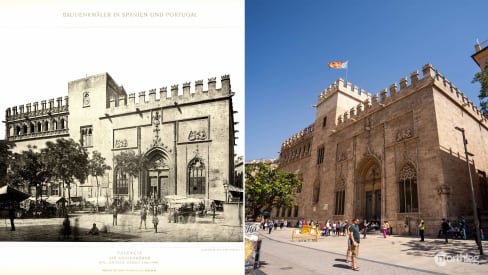Brief history
Brief history
The Lonja is the building that best exemplifies the flourishing wealth of Valencia’s Golden Age, the 15th century. The reason why this piece of Valencian civil gothic architecture exists as we know it today is the commercial boom experienced at the time.

During this period, commerce became the basis of the Valencian economy, and the city became a pivotal point of exchange, in terms of the Mediterranean area.
It had trade relations with cities in France, Italy and North Africa. The city became rich and grew in demographic, cultural, and artistic terms.
-
Before 1238
The origins of the Exchange
When the Santos Juaneschurch was still a mosque, under Moorish rule, the space was already an area of tradesmen and merchants.
-
Late 13th-early 14th century
An early Exchange
In Plaça del Doctor Collado, the old Exchange already existed. It was known as Llotja de l’Oli, meaning Oil Exchange, even though other mercantile operations were carried out, too.
-
14th-15th century
Valencia’s Golden Age
Valencia was living a time of prosperity and development, unaffected by the political problems in Catalonia and Aragon. With this commercial revolution, the local bourgeoisie acquired strength and prestige. The acquisition of capital by the emerging middle-classes meant that the city needed a new exchange to meet its needs and showcase its power.
-
1469
Project plans
When the old Exchange proved to be insufficient, the Consell General de la Ciutat (General City Council) decided to construct a new building to meet the conditions and facilities required by Valencia’s booming trade. This was an institution created in the mid-1200s with the aim of organising local public life in the name of the king.
-
1481
Architects chosen
Pere Compte and other stonemasons and architects were selected for the construction of the building.
-
1482
The land
The City counsel demolished 25 houses to obtain a plot of land for the new building. The first stone was officially laid there on 7th November 1482.
-
1483
Beginning of construction
The construction officially began on 5th February 1483.
-
1506
Pere Compte’s death
The main architect, Pere Compte, died in 1506 without having seen the completion of his work. Works on the Consulate Pavilion continue without him.
-
1548
Construction ends
The Lonja was finally completed after 66 years. It was referred to as Lonja de los Mercaderes (Merchants’ Exchange) or Lonja de la Seda (Silk Exchange) because of the activities carried out under its roof.
-
1701–1762
Military station
The building was used by the military as a temporary accomodation.
-
1854–1855
Hospital
The building was used as a makeshift hospital during the cholera wave.
-
1939
Spanish Parliament
The building was used to house the Republican government at the end of the Spanish Civil War.
-
1995
World Heritage status
UNESCO declared the site a World Heritage Site in December 1995.















